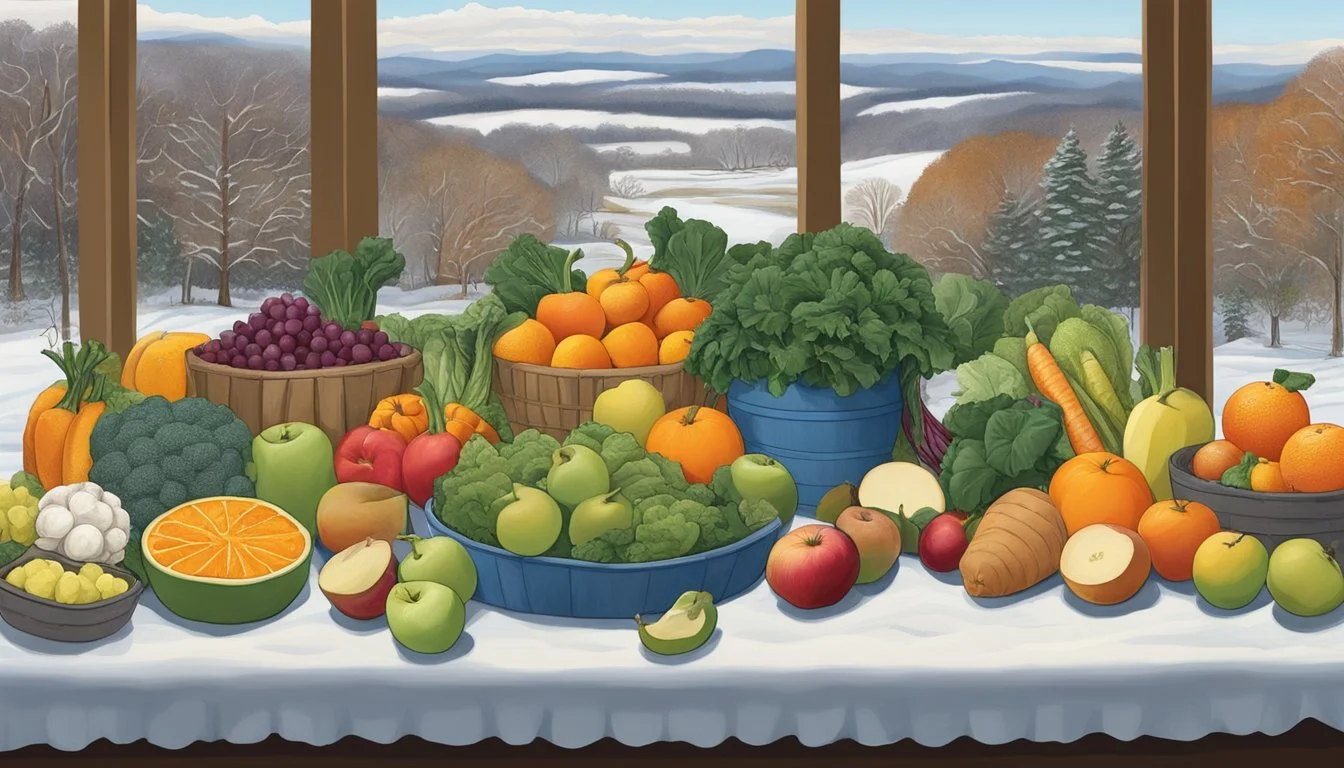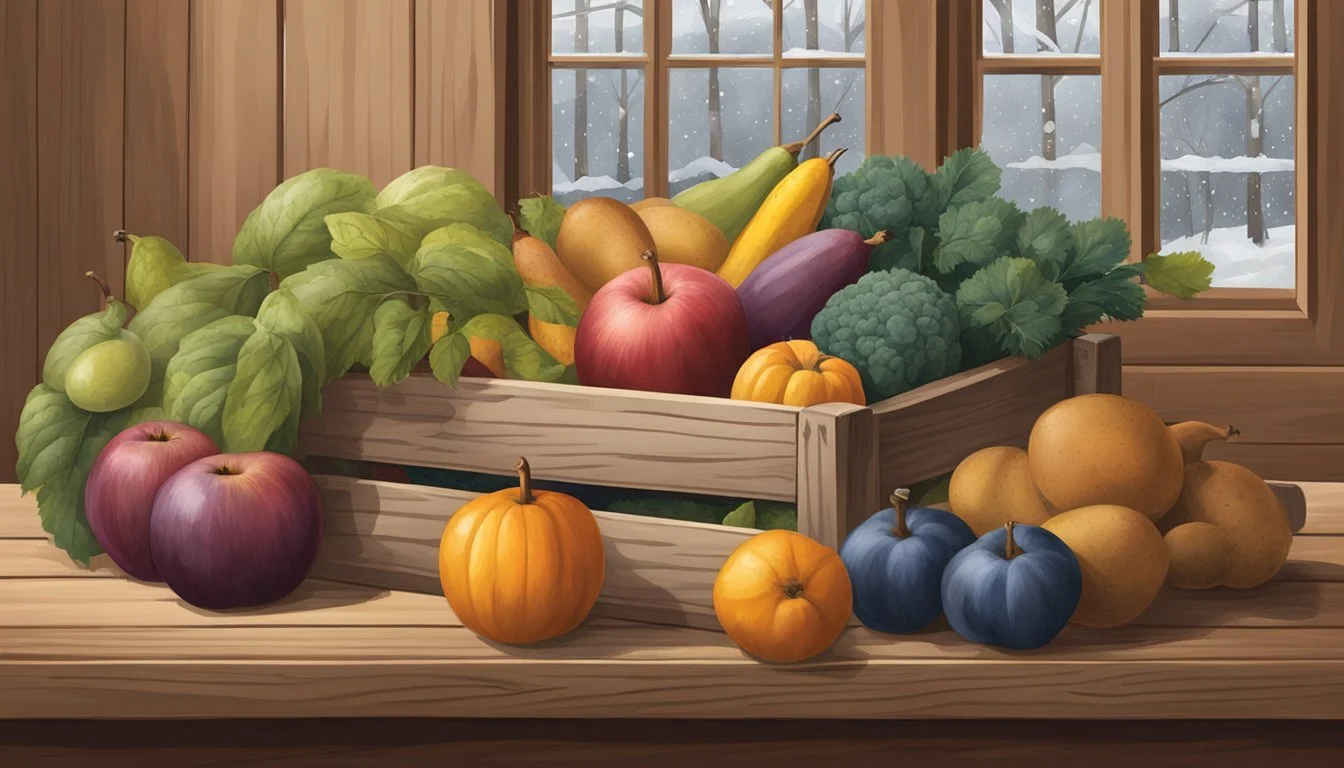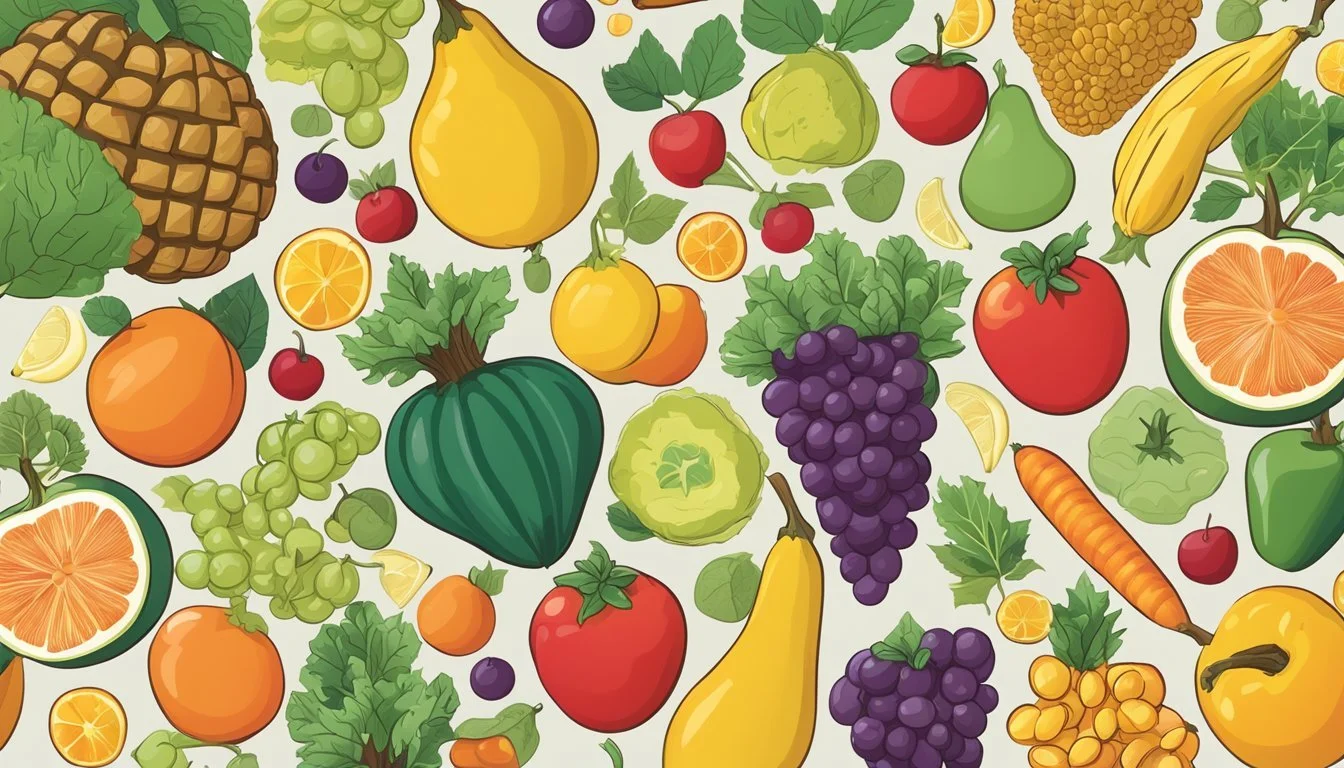North Carolina Seasonal Fruit & Vegetables in December
A Fresh Guide to Winter Produce
This Article is Part of our North Carolina Seasonal Fruit & Veg Calendar
In North Carolina, December marks a period of chilly weather and the closing of the harvest season, yet it remains a month where certain fruits and vegetables reach their peak. Throughout the state's varying climates, from the coastal plains to the rugged mountains, December offers a unique assortment of produce. Customers looking for the freshest options during this time can find a selection of fruits and vegetables that are grown locally and harvested in December.
Seasonal fruits such as muscadine grapes continue to be available early in the month, providing a sweet and tart flavor that is synonymous with the region's agricultural offerings. Meanwhile, apples, a staple in many North Carolina orchards, remain in season, having varieties that last well into the winter months. On the vegetable front, root vegetables and winter greens are especially prominent. Items like sweet potatoes (What wine goes well with sweet potatoes?) , a celebrated North Carolina crop, along with an array of leafy greens, including collard greens, are in abundance due to their tolerance to the colder temperatures.
Consumers of North Carolina produce are encouraged to take advantage of these seasonal fruits and vegetables as they are often more flavorful and nutrient-dense. By choosing local and seasonal produce, one not only supports the state's economy but also has access to fresher, tastier food options. Whether included in holiday meals or consumed as part of a regular diet, December's seasonal produce in North Carolina is a testament to the region's rich agricultural diversity.
Seasonal Overview
As December unfolds in North Carolina, residents and visitors are presented with an array of fresh produce choices that are shaped by the state's unique climate and growing conditions. This month is characterized by a diverse selection of fruits and vegetables that exemplify the importance of seasonal eating.
Climate and Growing Conditions
In North Carolina, the climate is typically mild in December, though with varying temperature ranges across the coastal plains, rolling hills of the Piedmont, and the Appalachian mountains. The state's growing season is largely influenced by these geographic features, creating distinct microclimates that are conducive to different types of agriculture. As a result, while some areas may be winding down their harvest, others can still offer fresh produce.
December's Seasonal Produce
Vegetables:
Brussels sprouts (October through December)
Butter Beans (July and August, with end of season availability)
Cabbage (May through December)
Cauliflower (October through December)
Sweet Potatoes (Typically year-round, peak in the fall and winter)
Turnips (Typically available in late autumn and winter months)
Fruits:
Apples (August through February, with late varieties available)
Muscadine Grapes (July to October, with potential stock lasting into December)
Pears (Late summer through winter)
Importance of Seasonal Eating
Seasonal eating in December means enjoying vegetables like Brussels sprouts and root vegetables such as turnips that thrive in the cooler temperatures. Fruits like apples, which can be stored and remain firm long after their harvest, are staples. By choosing seasonal produce, consumers support local agriculture, benefit from higher nutritional content, and experience the freshest flavors.
Winter Fruits and Vegetables
Winter in North Carolina brings a selection of hardy fruits and vegetables that withstand the colder temperatures. Root vegetables thrive, leafy greens reach peak flavor, and winter squash varieties provide comforting dishes for the season.
Root Vegetables
Root vegetables are particularly robust during the colder months, offering a variety of nutritional options:
Turnips: These can be found fresh in December, providing a slightly sweet and peppery flavor that enriches winter dishes.
Carrots: Available year-round, carrots harvested in the winter often have a concentrated sweetness.
Radishes: Offering a crisp texture and a peppery kick, radishes are in season and perfect for adding a fresh element to meals.
Beets (how long do beets last?): Known for their earthy flavor and deep red color, beets are ideal for roasting or pickling during this time.
Leafy Greens
Leafy greens thrive in cooler weather, becoming sweeter and more flavorful:
Kale: This nutrient-dense green is abundant and can be used in everything from salads to soups.
Spinach: It sees a peak in flavor when grown in cold weather, providing a versatile ingredient for various dishes.
Collards: A Southern staple, collards are a winter favorite known for their mild, smoky taste.
Winter Squash
Hearty and versatile, these gourds are a staple in many winter recipes:
Butternut Squash: (how long does butternut squash last?) With a sweet, nutty taste, butternut squash is perfect for soups and purees and is readily available throughout winter.
Healthy Eating in December
December's bounty in North Carolina offers a variety of fruits and vegetables that are not only fresh and flavorful but also packed with nutritional benefits perfect for the season. From fiber-rich root vegetables to antioxidant-packed greens, the produce available provides numerous ways to create wholesome meals.
Nutritional Benefits
The produce available in December is dense with nutrients essential for maintaining health during the colder months. Root vegetables like carrots and sweet potatoes are high in fiber and beta-carotene, which the body converts into vitamin A, crucial for eye health and immune function. Brussels sprouts and kale, both belonging to the cruciferous vegetable family, are rich in antioxidants and vitamin C, important for cell repair and immunity.
Apples, a versatile fruit still in season, are not only high in fiber but also provide vitamin C and quercetin, an antioxidant that may have anti-inflammatory properties. Incorporating these seasonal fruits and vegetables into daily meals can contribute significantly to a balanced diet, providing the body with necessary vitamins and minerals.
Recipe Ideas
This season's harvest lends itself to a variety of meal preparations that can suit any dietary preference. Salads made with kale or mixed greens can be a refreshing start to a meal or a light lunch option, with the added benefit of fiber and essential nutrients.
For heartier meals, soups and stews are perfect. They can be made with a base of carrots, celeriac (celery root), and sweet potatoes, which contribute depth of flavor and robustness, alongside the bonus of vitamins and fiber.
To enjoy the full flavor and nutritional profile of winter vegetables, roasting them is an excellent choice. Roasted Brussels sprouts and butternut squash not only make for a comforting side dish but also include essential nutrients that can help boost immunity during flu season. The high heat from roasting caramelizes the natural sugars in vegetables, enhancing their taste and making them an appealing addition to any meal.
Local Farming and Markets
In December, North Carolina's local farming community thrives by supplying seasonal produce through various farmers markets. These markets serve as pivotal points of sale for state-grown fruits and vegetables, reinforcing the local food economy.
Farmers Markets
North Carolina hosts numerous farmers markets where fresh, seasonal produce is a staple. In December, these markets typically offer:
Fruits: apples, muscadine grapes
Vegetables: radishes, sweet potatoes, winter squash, collard greens
Farmers from across the state bring their harvests directly to consumers, allowing for fresh and nutritious options that support the local supply chain.
Supporting Local Farms
Supporting local farms in North Carolina is essential to maintain a sustainable and resilient food system. Consumers can assist these farms by:
Shopping at farmers markets or farm stands
Joining Community Supported Agriculture (CSA) programs
Purchasing seasonal produce to ensure freshness and reduce transportation emissions
By engaging with local farms, individuals contribute to the state's agricultural prosperity and the health of the local economy.
Food Preservation Techniques
Preservation techniques are essential for extending the shelf life of North Carolina's seasonal produce. By employing methods like canning and freezing, or fermenting and pickling, individuals enhance the usability of both fruit and vegetables far beyond their freshest points.
Canning and Freezing
Canning is a method that entails processing food at high temperatures to eliminate bacteria and enzymes before sealing it within jars. This allows for it to be stored safely for years. In December, one can preserve produce like Brussels sprouts and cabbage, which are seasonal at that time. The freshest vegetables are ideal for this method to help maintain nutritional value and taste.
Benefits of Canning:
Extends shelf life significantly
Maintains taste and nutritional value when using fresh produce
Freezing, on the other hand, involves storing food at extremely low temperatures. This method retains the texture and flavour of raw products, making it suitable for fruits like cranberries, which are in season during December.
Benefits of Freezing:
Retains the raw texture and taste of produce
Quick and convenient preservation method
Fermenting and Pickling
Fermenting is the metabolic process of converting carbohydrates to alcohol or organic acids using microorganisms under anaerobic conditions. Vegetables like cabbage, which are plentiful in December, can be transformed into products like sauerkraut through fermentation.
Benefits of Fermenting:
Enhances the nutritional profile with probiotics
Pickling involves immersing foods in an acidic solution, such as vinegar, or through anaerobic fermentation in brine. This method does not only preserve the food but also imparts a distinct sour flavor. Root vegetables available in December, such as turnips, can be effectively pickled.
Benefits of Pickling:
Provides a long shelf life
Offers a unique taste profile to preserved foods
Month-wise Produce Guide
The month of December in North Carolina is abundant with a variety of fruits and vegetables fit for the holiday season. This guide pinpoints what produce is fresh and how to incorporate it into holiday planning.
What's Fresh in December
In December, a range of hearty vegetables and sweet, crisp fruits are ready to be harvested. Root vegetables and leafy greens dominate the selection, providing both nutrition and flavor for seasonal dishes.
Root Vegetables:
Beets
Carrots
Turnips
Radishes
Leafy Greens:
Kale
Collards
Mustard Greens
Spinach
Other Vegetables:
Sweet Potatoes
Winter Squash
Fruits:
Apples
Planning for the Holiday Season
When planning holiday menus, one can look to the fresh produce available in December as inspiration. These items can be used to create comforting soups, savory stews, and festive side dishes that embrace the flavors of the season.
Holiday Dishes:
Roasted Root Vegetables
Apple Pies and Crisps
Butternut Squash Soup
Sauteed Greens
Decoration:
Use fresh Holly or Mistletoe for decoration, which can also be sourced locally during this time.
Farmers' markets and local grocery stores are stocked with these seasonal items, making it easy to support local agriculture while enjoying the freshest foods available.
Social Media and Engagement
In North Carolina, the role of social media platforms is paramount in promoting seasonal eating habits and fresh produce. They connect consumers with markets and local farms, driving awareness and consumption of December fruits and vegetables.
Promoting Seasonal Eating
Social media channels, such as Facebook, Twitter, and Pinterest, serve as vital tools for spreading the word about seasonal produce available in North Carolina during December. Local markets utilize these platforms to update followers on the latest harvests and available produce, encouraging community engagement and support for local agriculture.
On Facebook, markets often post vibrant images of December produce like Brussels sprouts and winter squash, along with recipes to inspire seasonal cooking. They also share events such as holiday markets or cooking demonstrations that showcase the use of local fruits and vegetables.
Twitter can be used for quick, timely updates, alerting followers to limited-time offers or freshly stocked items at their nearby markets. Farms and markets might tweet about the arrival of fresh root vegetables or holiday specials, prompting immediate consumer action.
Pinterest is ideal for sharing visually appealing content, such as infographics of what’s in season or pinboards featuring recipes that highlight December produce like sweet potatoes and collards. These pins often link back to the websites of local markets or farms, thereby increasing traffic and potential sales.
By leveraging these social media platforms, North Carolina markets and farms effectively engage with their communities. They foster a sense of local pride and encourage healthy, sustainable eating practices tied to the seasons.









